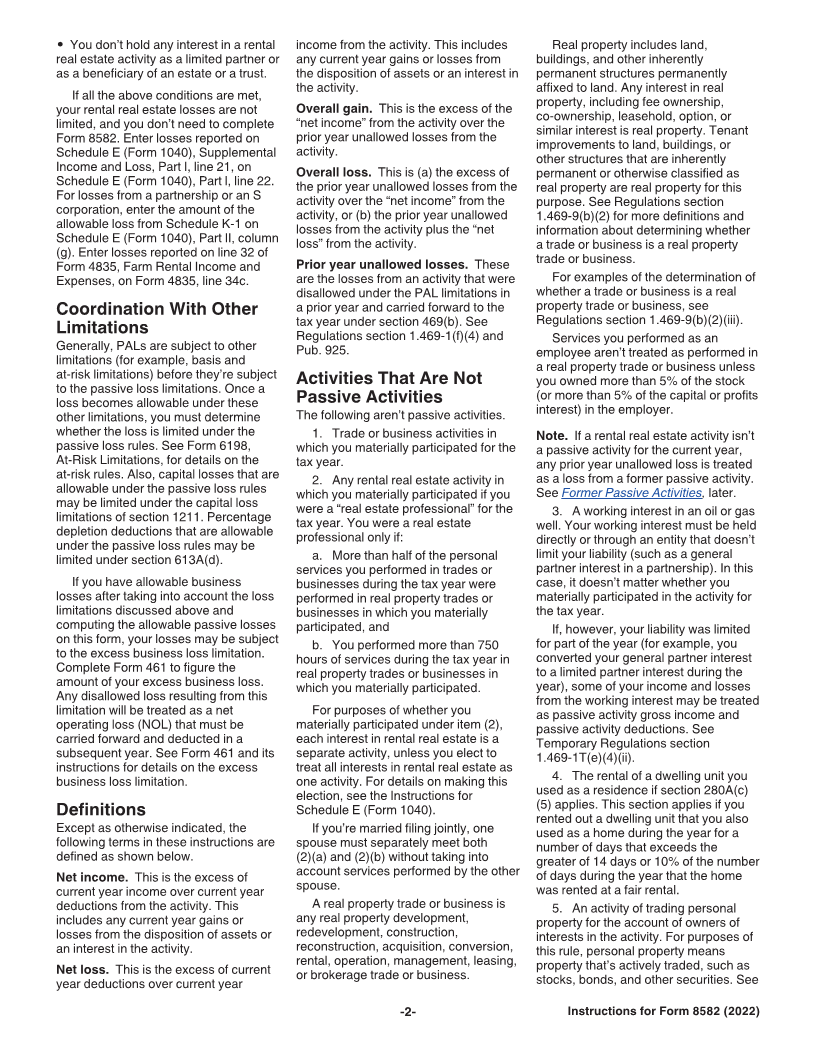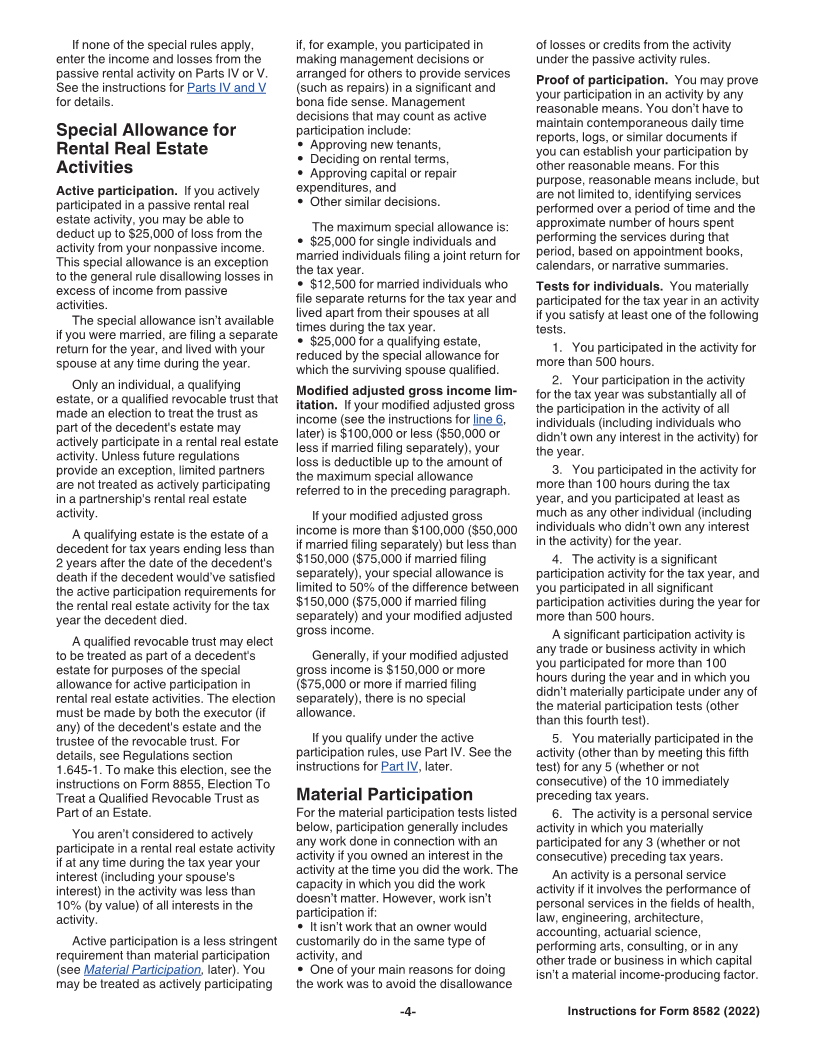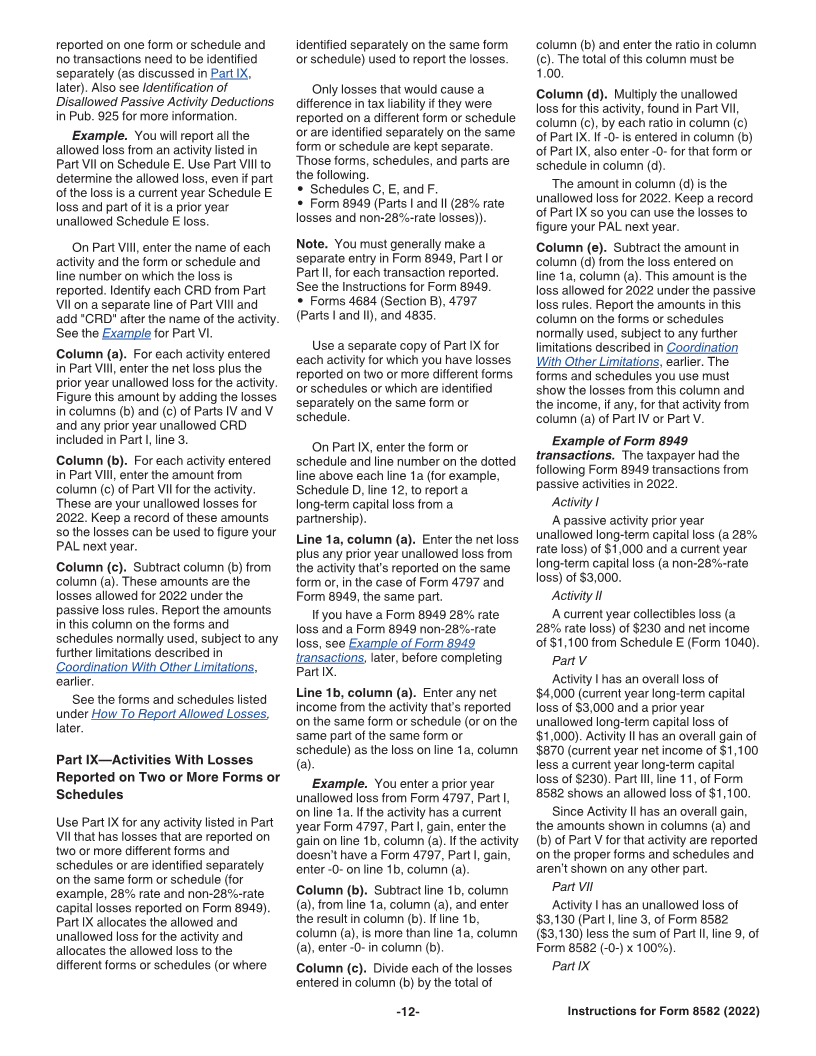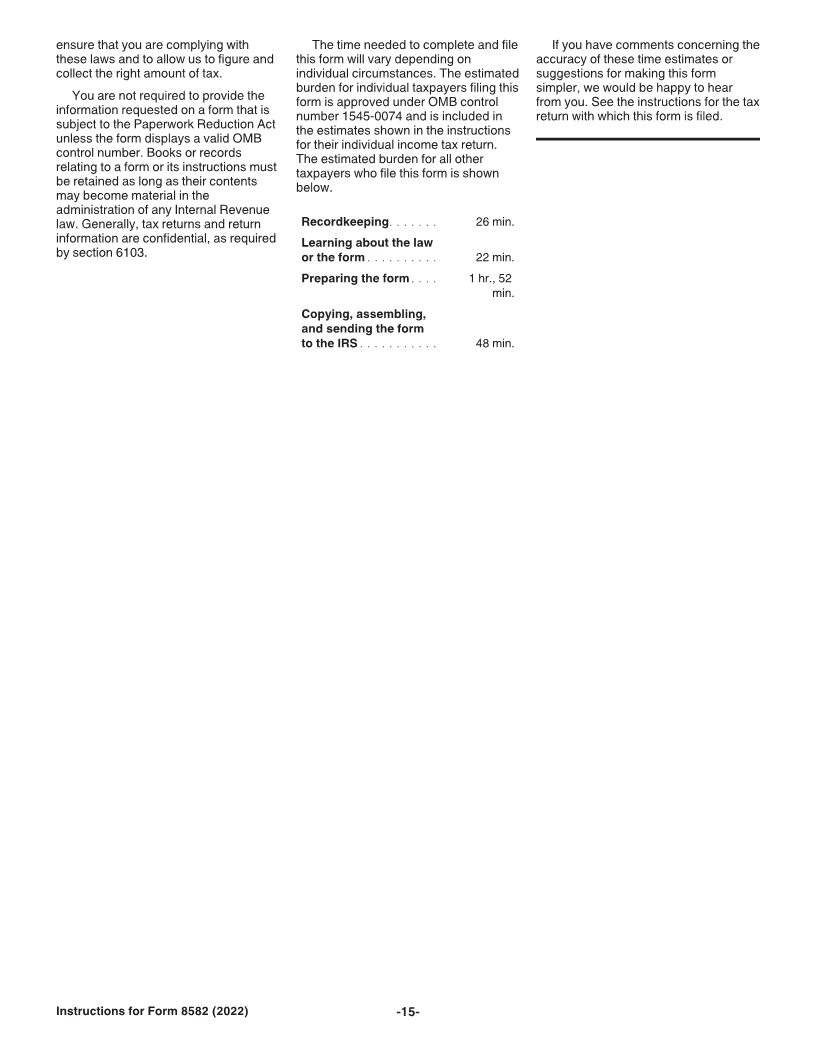
Enlarge image
Userid: CPM Schema: Leadpct: 100% Pt. size: 9.5 Draft Ok to Print
instrx
AH XSL/XML Fileid: … ions/i8582/2022/a/xml/cycle01/source (Init. & Date) _______
Page 1 of 15 10:14 - 6-Oct-2022
The type and rule above prints on all proofs including departmental reproduction proofs. MUST be removed before printing.
Department of the Treasury
Internal Revenue Service
2022
Instructions for Form 8582
Passive Activity Loss Limitations
Section references are to the Internal Revenue Regulations section 1.469-1T(e)(6) • Rental activities, regardless of your
Code unless otherwise noted. subject to section 163(d)(5)(A)(ii) participation.
involving a non-passive trade or
Future Developments business in which the taxpayer does not PALs can’t be used to offset income
For the latest developments related to materially participate, with any other from nonpassive activities. However, a
Form 8582 and its instructions, such as activity or activities of the taxpayer. See special allowance for rental real estate
legislation enacted after they were Regulations section 1.469-4(d)(6) for activities may allow some losses even if
published, go to IRS.gov/Form8582. more details. the losses exceed passive income.
Definition of real property trade or PALs not allowed in the current year
General Instructions business. T.D. 9905 and 9943 are carried forward until they’re allowed
expanded Regulations section either against passive activity income;
What’s New 1.469-9(b)(2) to define several terms against the special allowance, if
used in determining whether a trade or applicable; or when you sell or
Prior year unallowed commercial re-
business is a real property trade or exchange your entire interest in the
vitalization deduction (CRD). If you
business for purposes of section 469(c) activity in a fully taxable transaction to
have prior year unallowed CRDs limited
(7)(C). T.D. 9905 added Regulations an unrelated party.
by the passive loss rules, you may
sections 1.469-9(b)(2)(ii)(H) and (I)
continue to include them in the For more information, see Pub. 925,
defining real property operations and
calculations as shown in the Specific Passive Activity and At-Risk Rules.
real property management,
Instructions, beginning with Part
respectively. T.D. 9943 added
I—2022 Passive Activity Loss, later. Note. Corporations subject to the
Regulations sections 1.469-9(b)(2)(ii)
(A) and (B) defining real property passive activity rules must use Form
Reminders development and real property 8810, Corporate Passive Activity Loss
Excess business loss limitation. If redevelopment, respectively. and Credit Limitations.
you are a noncorporate taxpayer and Reporting prior year unallowed los- Who Must File
have allowable business losses after ses. Form 8582 must generally be filed
Form 8582 is filed by individuals,
taking into account first the at-risk by taxpayers who have an overall gain
estates, and trusts who have passive
limitations and then the passive loss (including any prior year unallowed
activity deductions (including prior year
limitations (this form), your losses may losses) from business or rental passive
unallowed losses). However, you don’t
be subject to the excess business loss activities. See Exception under Who
have to file Form 8582 if you meet the
limitation. After taking into account all Must File, later.
the other loss limitations, complete following exception.
Form 461, Limitation on Business Regrouping due to Net Investment
Losses, to figure the amount of your Income Tax. You may be able to Exception
excess business loss. See Form 461 regroup your activities if you’re subject You actively participated in rental real
and its instructions for details on the to the Net Investment Income Tax. See estate activities (see Special Allowance
excess business loss limitation. Regrouping Due to Net Investment for Rental Real Estate Activities, later),
Income Tax under Grouping of and you meet all of the following
Changes in rules on grouping and Activities, later, for more information. conditions.
definition of real property trade or • Rental real estate activities with
business. Treasury Decision (T.D.) active participation were your only
Purpose of Form
9943 revised certain rules in the passive activities.
regulations under section 469. Form 8582 is used by noncorporate
taxpayers to figure the amount of any • You have no prior year unallowed
Applicable date. The new rules passive activity loss (PAL) for the losses from these (or any other passive)
apply to tax years beginning on or after current tax year and to report the activities.
March 22, 2021, but taxpayers may application of prior year unallowed • Your total loss from the rental real
choose to adopt these rules earlier. See PALs. estate activities wasn’t more than
$25,000 ($12,500 if married filing
Regulations section 1.469-11(a)(1) and A PAL occurs when total losses separately).
(4) for additional information on (including prior year unallowed losses) • If you’re married filing separately, you
applicability dates and early adoption. If from all your passive activities exceed lived apart from your spouse all year.
you are a calendar year taxpayer, the the total income from all your passive • You have no current or prior year
new provisions apply to you in calendar activities. unallowed credits from a passive
year 2022.
Generally, passive activities include activity.
Grouping rules. T.D. 9943 added the following. • Your modified adjusted gross income
Regulations section 1.469-4(d)(6), • Trade or business activities in which (see the instructions for line 6, later) was
which prohibits grouping of trading you did not materially participate for the not more than $100,000 (not more than
activities described in Temporary tax year. $50,000 if married filing separately).
Oct 06, 2022 Cat. No. 64294A













